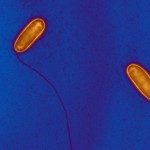Link to Pubmed [PMID] – 25916986
Infect. Immun. 2015 Jul;83(7):2738-50
The secretion of bacterial toxin proteins is achieved by dedicated machineries called secretion systems. The type VI secretion system (T6SS) is a widespread versatile machine used for the delivery of protein toxins to both prokaryotic and eukaryotic cells. In Salmonella enterica serovar Typhimurium, the expression of the T6SS genes is activated during macrophage or mouse infection. Here, we show that the T6SS gene cluster is silenced by the histone-like nucleoid structuring H-NS protein using a combination of reporter fusions, electrophoretic mobility shift assays, DNase footprinting, and fluorescence microscopy. We further demonstrate that derepression of the S. Typhimurium T6SS genes induces T6SS-dependent intoxication of competing bacteria. Our results suggest that relieving T6SS H-NS silencing may be used as a sense-and-kill mechanism that will help S. Typhimurium to homogenize and synchronize the microbial population to gain efficiency during infection.

